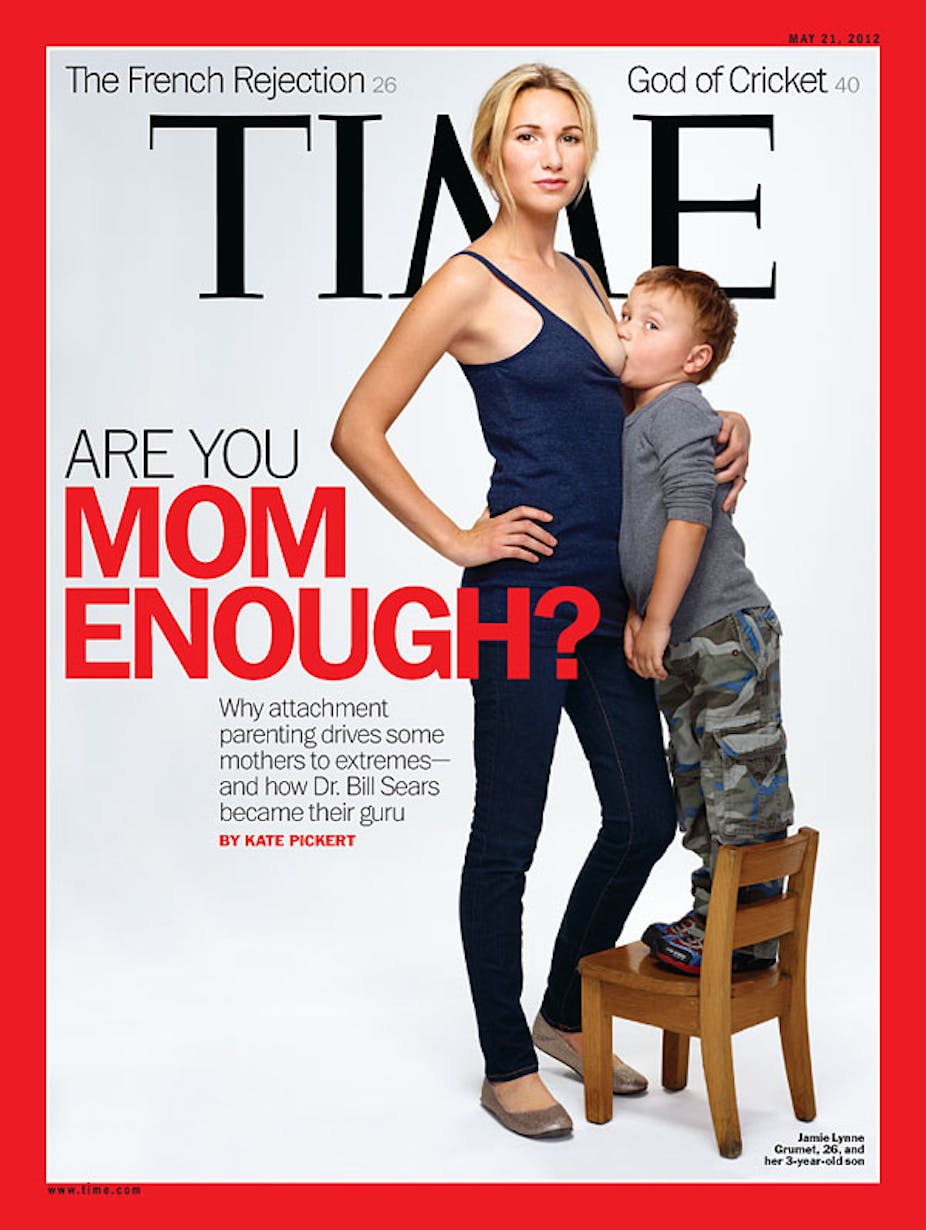Breastfeeding generally falls under the jurisdiction of mothers, so I decided to ask a group of mothers I see regularly on Saturday morning what they thought of the recent Time magazine cover portraying an attractive young woman, hand on hip, staring down the camera while her passive three-year-old dressed in cargo pants stands on a chair and suckles from her exposed left breast.
What they told me was deeply reassuring.
Is it wrong to breastfeed a three-year-old? “No, I wouldn’t do it, but there’s nothing wrong with it,” said one mother helpfully. “It’s not immoral”.
All agreed in fact; it’s a question of choice, culture, circumstances, needs, and so on.
How about an 11-year-old? (I got daggers for that one.) “Other kids will let you know when it’s gone too far!”
Further prodding revealed a commitment to breastfeeding because of the nutritional benefits it confers on the baby, a sentiment shared by the young woman pictured on the cover of Time magazine, Los Angeles mum Jamie Lynne Grumet, who engages in “attachment parenting”.
Attachment parenting is a popularization of “attachment theory”, a long-standing ethological approach to the study of human relationships. Attachment theory has been dominated by two very big ideas. The first concerns the universality of attachment bonds emerging in infancy and their importance for protection, state regulation, and healthy development.
The second concerns the distinctive ways in which attachment bonds form in individual mother-infant pairs. This latter approach attempts to define optimal or secure attachment in terms of the infant’s capacity to effectively get the mother’s protection and care in times of need, such as when fear or anxiety are experienced, or when frustrations become too great.
It’s no exaggeration to say that hundreds of research studies have been devoted to understanding the underpinnings and consequences of secure attachment. Many researchers working in the field believe the key to security lies in the mother’s prompt and sensitive responses to her infant’s needs. But of course this can mean many things.
For the proponents of attachment parenting, there tends to be an intense focus on physical closeness (including breastfeeding, co-sleeping, and “baby-wearing”) and responsiveness to infant cries.
But let’s be clear, the majority of babies that have ever been studied in psychological research (and there are many thousands) have been securely attached to their mothers. Further, all this has been achieved without attachment parenting philosophies.
In fact, secure attachment is the norm. Most children develop strong affectionate ties to their caregivers that we recognize as loving, and they are able to rely on these relationships throughout development to support them in positive ways.
So what goes wrong? What undermines secure attachment?
The great British pediatrician and psychoanalyst Donald Winnicott argued that infants and children usually get what they need from their mothers. He coined the phrase “good enough mother” to convey his view that perfection doesn’t exist when it comes to parenting. And, even if it did, he added, it would undermine children because it would rob them of their autonomy.
But like many who have followed, Winnicott understood that various factors could prevent a mother from being able to recognise her infant’s needs and appropriately respond to his signals. In particular, ill health (including mental health problems) and environmental stress are prime candidates.
In more recent attachment theory, there’s also some consensus emerging that the mother’s state of mind can undermine her natural capacity to understand and respond to infant signals, such as when she is preoccupied with her own ongoing concerns or is psychologically unavailable.
A final question for the mothers: is there a right time to stop breastfeeding? “You should stop when one or both of the participants is no longer comfortable,” quietly and thoughtfully stated.
This last sentiment carries a lot of wisdom; it reminds us that there’s a relationship between a mother and her infant and the act of breastfeeding is one of the most salient and powerful forums in which the early relationship is played out during the prolonged infancy that humans experience.
It is so tempting to cast breastfeeding in terms of nutritional needs and health, but attachment theory actually presents us with a radical alternative: the biological imperative is not mothers’ milk, nutritional though it may be, it is the relationship itself. When the bonds of affection are in place, the food will come.
So, what is wrong with this picture? For the mothers I spoke to on Saturday morning, it violates precisely what it is that they value about the act of breastfeeding – it is devoid of love, tenderness, warmth or affection. You don’t need to be a developmental psychologist to see this.
My Saturday morning companions hit the nail on the head: this picture is about the mother, her own ongoing issues and preoccupations. No matter how justified these may be, they have no place in the care of infants and children precisely because they prevent us from seeing children for who they are. They prevent us from reading the signals coming from the child and responding to them appropriately and with sensitivity.
That this truth was so obvious to my companions is deeply reassuring, no wonder most children are securely attached.
Read more stories on Time’s controversial cover:
Time #2: Extreme parenting, Time magazine style
Time #3: Why does it hurt to look at a woman breastfeeding?
What do you think of the image and the article? Leave your comments below

